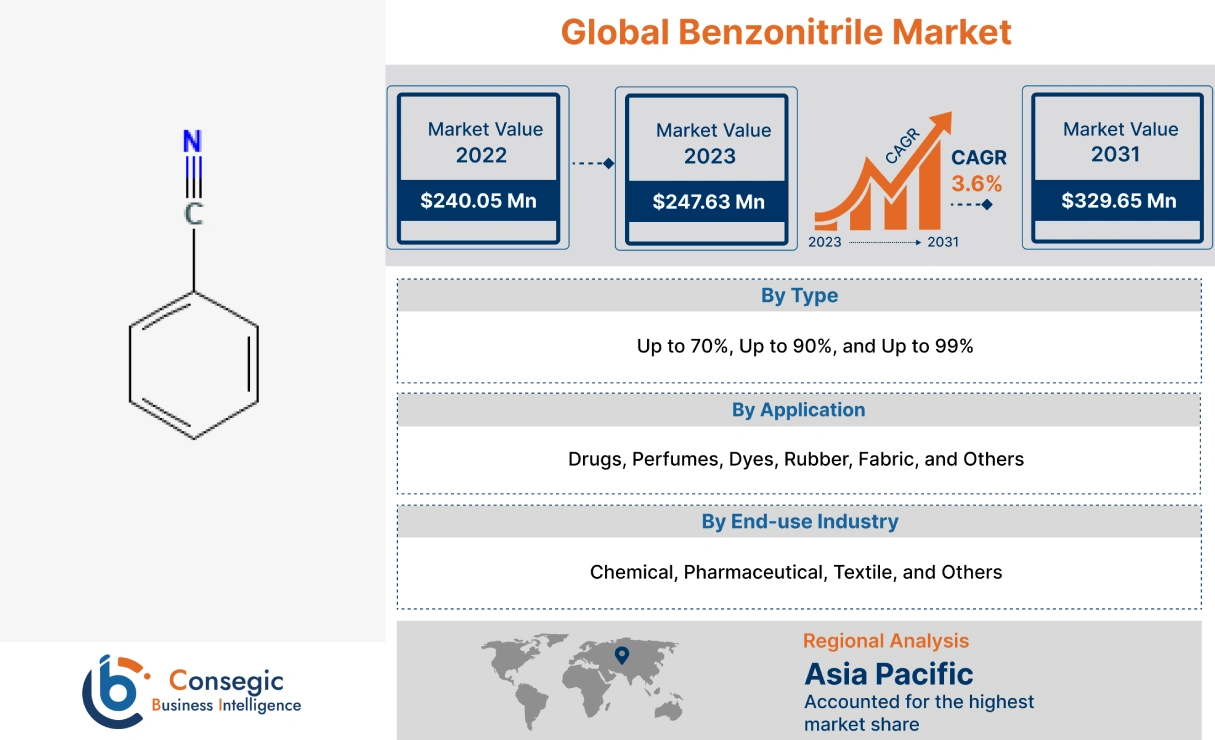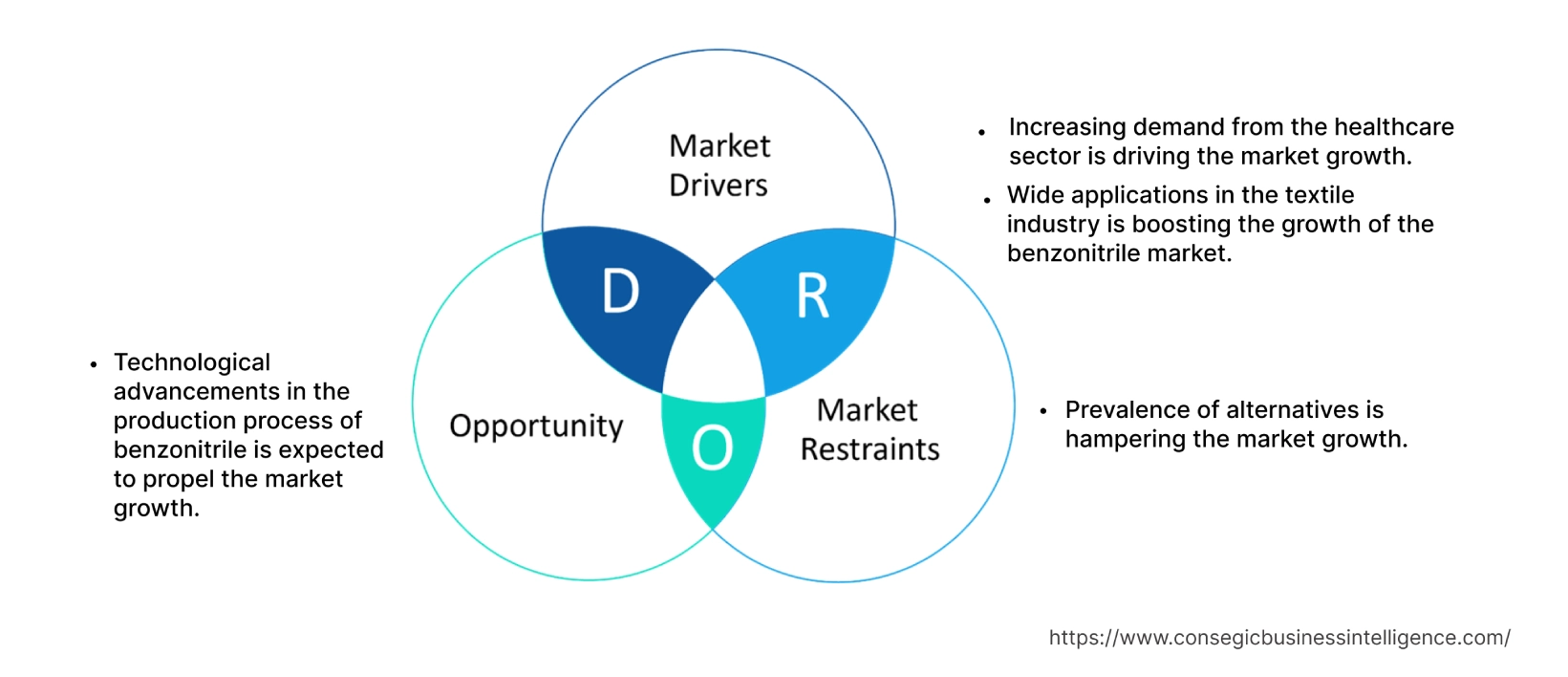- Summary
- Table Of Content
- Methodology
Benzonitrile Market Size :
Consegic Business Intelligence analyzes that the benzonitrile market size is growing with a CAGR of 3.6% during the forecast period (2023-2031), and the market is projected to be valued at USD 329.65 million by 2031 and USD 247.63 million in 2023 from USD 240.05 million in 2022
Benzonitrile Market Scope & Overview:
Benzonitrile is a colorless, oily liquid with a sweet and bitter almond odor. The liquid is used as a solvent for nitrile rubber, resins, polymers, and metal salts. Benzonitrile is also used as an intermediate in the production of various chemicals and pharmaceuticals. Furthermore, it is also used as a solvent in various industries such as paints & coatings, textiles, and plastics. Moreover, the chemical is used as a precursor to synthesize a wide range of aromatic compounds. Benzonitrile is a key ingredient in the synthesis of benzoic acid, benzylamine, benzamide, pesticides, and dyes. It is also an intermediate for the production of benzoguanamine, which is a widely used advanced coating. Also, the chemical is denser than water and slightly soluble in water.
Benzonitrile Market Insights :
Key Drivers :
Increasing demand from the healthcare sector is driving the market growth
Benzonitrile is widely used in the healthcare sector for the preparation of antitumor drugs and is used as a solvent and intermediate in the production of other drugs. Benzonitrile derivatives are used in the synthesis of several antibiotics, such as cefazolin, cefoxitin, and cefotaxime. Furthermore, benzonitrile is also used in the synthesis of antiviral drugs, such as lamivudine and stavudine, and the synthesis of several anticancer drugs.
Furthermore, the chemical is also used in the development of new healthcare technologies, such as 3D-printed medical implants and drug delivery systems. Also, increasing healthcare infrastructure and the healthcare industry globally is leading to further demand for benzonitrile. For instance, according to a recent report by India Brand Equity Foundation, in 2023, the healthcare market in India reached around USD 372 billion in 2022. The report also talks about major initiatives taken by the Government of India to promote the Indian healthcare industry. Hence, increasing healthcare infrastructure and expansion of the healthcare industry is propelling the growth of the benzonitrile market.
Wide applications in the textile industry is boosting the growth of the benzonitrile market
Benzonitrile has wide usage in the textile industry for the production of synthetic fibers, such as polyester and nylon, performance textiles, and others. It can be used to produce sustainable textiles by using renewable resources, such as corn starch and others. Moreover, increasing demand for synthetic fibers due to their durability, wrinkle resistance, and low cost has been driving the demand for benzonitrile. Also, owing to the large demand for performance textiles the benzonitrile market is growing positively. Benzonitrile is also used in the production of textile coatings, which are applied to fabrics to improve their properties, such as durability, stain resistance, and water resistance. Thus, benzonitrile is playing an increasingly important role in the textile sector, which impacts the demand of benzonitrile across the globe.
Key Restraints :
Prevalence of alternatives is hampering the market growth
There are wide alternatives to benzonitrile commercialized in the market such as nitrobenzene, acetonitrile, benzyl cyanide, and others. Nitrobenzene is used as a substitute for benzonitrile in different industrial applications. Acetonitrile is a less toxic and less flammable alternative to benzonitrile. Benzyl cyanide is used as a substitute for benzonitrile in pharmaceutical and fine chemical applications as the chemical is a close substitute for benzonitrile. Hence, the wide number of alternative products and their specific advantages is hampering the growth of the market.
Future Opportunities :
Technological advancements in the production process of benzonitrile is expected to propel the market growth
Different technological advancements in the production process of benzonitrile such as the development of new catalysts, innovation of new reactor technologies, and others are propelling the benzonitrile market growth. Also, certain advanced separation, process control, and waste treatment technologies are expected to drive the benzonitrile market growth in the forecast period. Owing to these technologies being in a development phase, the production process of benzonitrile is expected to become even more sustainable and efficient. Due to increasing technological change, the cost of benzonitrile is reducing, making it more accessible to a wider range of industries. Hence, technological advancements have helped to improve the efficiency, safety, and environmental impact of the production process. For instance, in June 2023, Lonza developed a new process for the production of benzonitrile from renewable energy sources. This process is powered by 100% renewable energy, and it has a significantly lower carbon footprint than traditional processes. Thus, owing to the rising adoption of different technologies by the key players in the market for an efficient production process, the benzonitrile market is expected to flourish further in the forecast period.
Benzonitrile Market Report Insights :
| Report Attributes | Report Details |
| Study Timeline | 2017-2031 |
| Market Size in 2031 | USD 329.65 Million |
| CAGR (2023-2031) | 3.6% |
| By Type | Up to 70%, Up to 90%, and Up to 99% |
| By Application | Drugs, Perfumes, Dyes, Rubber, Fabric, and Others |
| By End-use Industry | Chemical, Pharmaceutical, Textile, and Others |
| By Region | North America, Europe, Asia-Pacific, Latin America, and Middle East & Africa |
| Key Players | Lonza, BASF, Evonik, Dow Chemical, Clariant, Huntsman, Eastman Chemical, Chemsavers Inc., Vineeth Precious Catalysts Pvt. Ltd., and Triveni Chemicals |
Benzonitrile Market Segmental Analysis :
By Type :
The type segment is categorized into up to 70%, up to 90%, and up to 99%. In 2022, the up to 99% segment accounted for the highest market share of 46.30% and is expected to grow at the fastest CAGR over the forecast period in the benzonitrile market. This is owing to 99% benzonitrile, being a high-purity grade of benzonitrile, and thus is widely demanded in different applications where a high degree of purity is required, such as in the pharmaceutical and fine chemical industries. 99% benzonitrile is used as a starting material for the synthesis of a variety of pharmaceuticals, such as antibiotics, antivirals, and anticancer drugs. The chemical is also used as a solvent and as a reagent in a variety of chemical reactions. Furthermore, 99% benzonitrile is also used as a reference standard and as a reagent in a variety of analytical experiments. Hence, due to the wide advantages of the type, up to 99% segment is witnessing significant growth in the benzonitrile market.
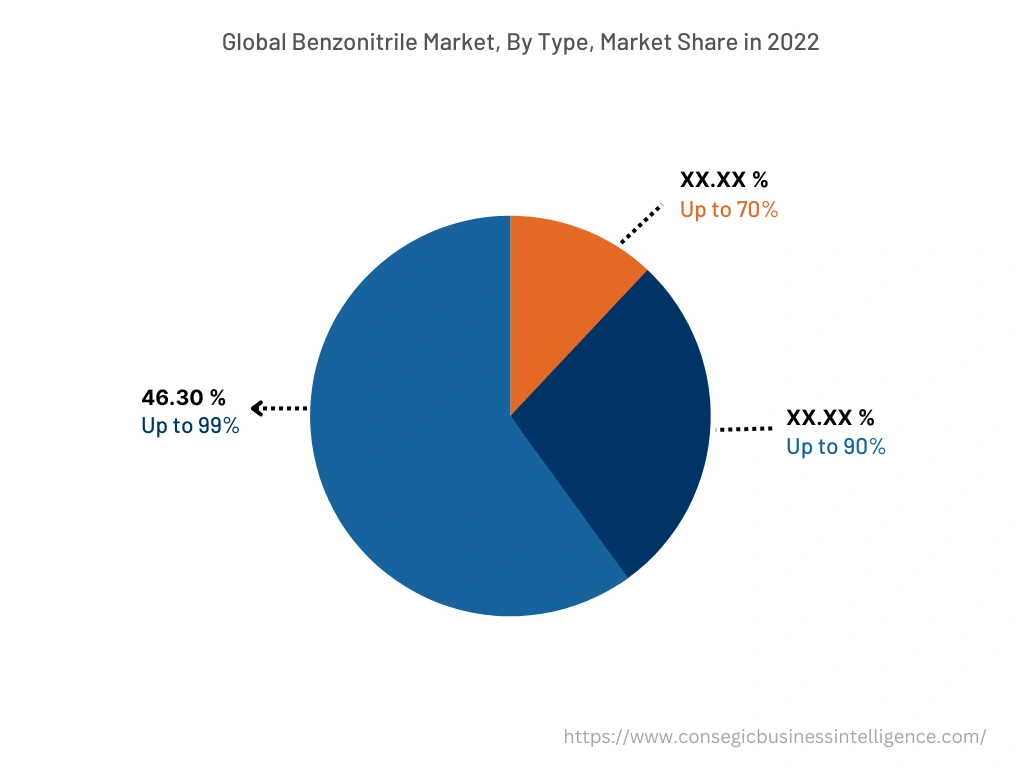
By Application :
The application segment is categorized into drugs, perfumes, dyes, rubber, fabric, and others. In 2022, the dyes segment accounted for the highest market share in the benzonitrile market. Benzonitrile is used as an intermediate in the production of a variety of dyes, such as azo dyes and anthraquinone dyes. These dyes are widely demanded to color a variety of textile products, including clothing, carpets, and upholstery. It is a versatile and inexpensive intermediate that can be used to produce a variety of dye molecules as it provides high color strength and durability. Hence, due to the aforementioned benefits of benzonitrile in dyes, the segment is experiencing significant growth in the benzonitrile market.
Moreover, the drugs segment is expected to grow at the fastest CAGR over the forecast period in the benzonitrile market. Benzonitrile is a chemical that is used in the production of a wide range of pharmaceutical drugs and is used as an intermediate in the synthesis of a variety of drug molecules, including antibiotics, antifungals, antiviral drugs, and others. Furthermore, increasing cardiovascular disorders have been driving a positive impact on the benzonitrile market growth. For instance, according to a report by the Centers for Disease Control and Prevention, in 2023, heart disease is the leading cause of death for men and women in the U.S., where one person dies every 33 seconds in the U.S. from cardiovascular disease. The report also mentions about 695,000 people in the U.S. died from heart disease in 2021. Hence, increasing demand for benzonitrile in different pharmaceutical drugs is propelling the growth of the segment in the benzonitrile market.
By End-Use-Industry :
The end-use industry segment is categorized into chemical, pharmaceutical, textile, and others. In 2022, the textile segment accounted for the highest market share in the benzonitrile market owing to benzonitrile being used as a finisher in the textile industry. The chemical can be used to create a water-repellent finish on textile products. Also, the product is widely used for the production of activewear, such as running shoes and yoga pants. Benzonitrile is widely used in the production of home textiles as well, such as curtains, carpets, and upholstery, and in the production of industrial textiles, such as conveyor belts and tarpaulins. Also, the growing textile industry globally is leading to larger usage of benzonitrile in the market. For instance, according to a recent report by Invest India in 2023, the Indian textile and apparel industry is expected to grow at 12% CAGR to reach around USD 250 Bn by 2030. Hence, the wide application of chemical in the textile industry and the growing textile and apparel industry globally is impacting the positive growth of the segment in the benzonitrile market.
Moreover, the pharmaceutical segment is expected to grow at the fastest CAGR over the forecast period in the benzonitrile market. Benzonitrile is a valuable intermediate in the pharmaceutical industry because it is relatively inexpensive and easy to produce. It is also a versatile intermediate that can be used to produce a wide range of drug molecules such as antibiotics, antifungals, antiviral drugs, and cardiovascular drugs. Benzonitrile is also used in the production of several antibiotics, including penicillin, cephalosporins, and quinolones. Hence, owing to the wide application of benzonitrile in the pharmaceutical industry, the segment is growing significantly in the benzonitrile market.
By Region :
The regional segment includes North America, Europe, Asia Pacific, Middle East and Africa, and Latin America.
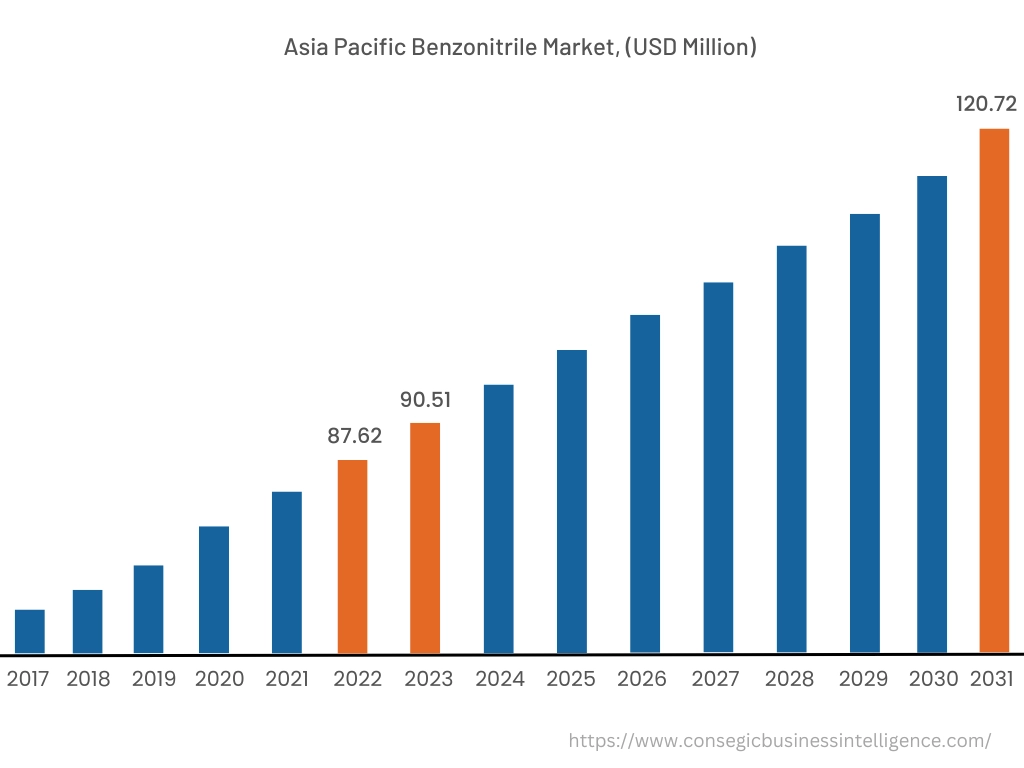
In 2022, Asia Pacific accounted for the highest market share at 36.50%, valued at USD 87.62 million in 2022 and USD 90.51 million in 2023, it is expected to reach USD 120.72 million in 2031. In Asia Pacific, China accounted for the highest market share of 22.04% during the base year 2022. The economies of Asia Pacific are growing rapidly, which is leading to increased industrial activity and growing demand for benzonitrile. Moreover, the growing demand for the chemical from end-use industries is driving the benzonitrile market growth further. Also, increasing industrialization in this region is acting as a catalyst for a larger demand for benzonitrile. For instance, according to a recent report by Invest India in 2023, the pharmaceutical industry in India is expected to reach around USD 65 billion by 2024 and around USD 130 billion by 2030. The report also mentions that India is a major exporter of pharmaceuticals serving over 200 countries globally. Hence, due to the wide utilization of the chemical in different end use industries and increasing industrialization across the region, the benzonitrile market is growing significantly in Asia Pacific.
Moreover, North America is expected to witness significant growth over the forecast period, growing at a CAGR of 4.1% during 2023-2031 owing to increasing demand from the textile and pharmaceutical sector. Also, North America governments support the benzonitrile manufacturers through various initiatives such as tax breaks and subsidies. This is helping to boost the growth of the benzonitrile market in this region. Furthermore, the growing demand for sustainable products and technological advancement in the products are acting as catalysts for the growth of the benzonitrile market in North America.
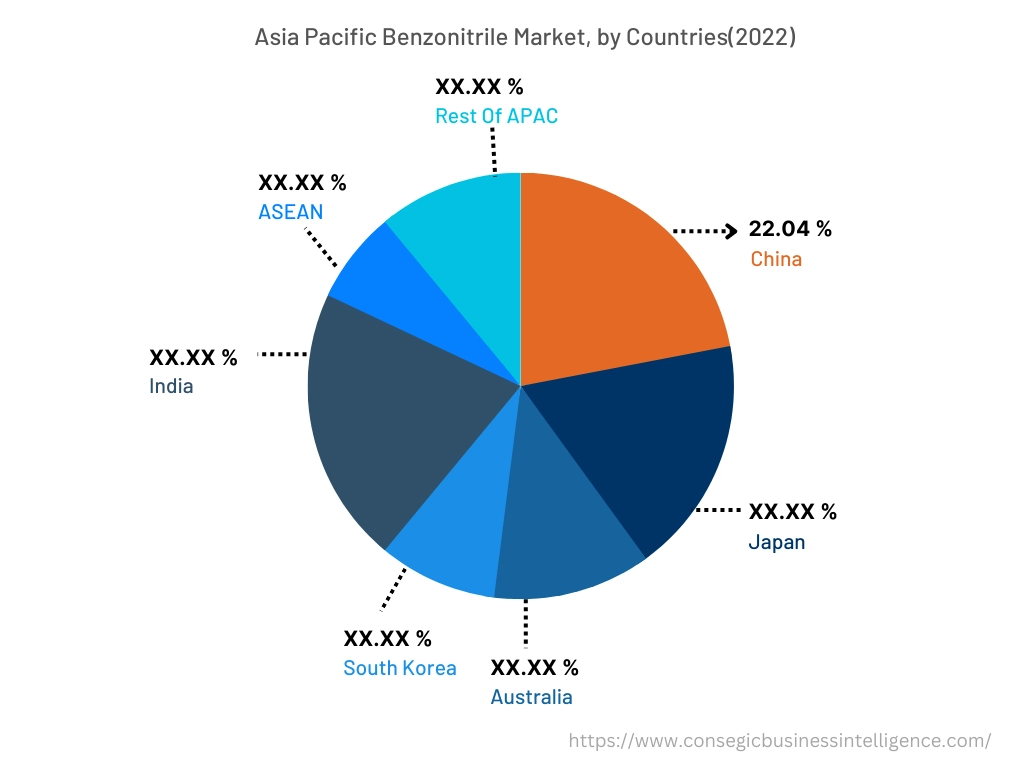
Top Key Players & Market Share Insights:
The benzonitrile market is highly competitive, with several large players and numerous small and medium-sized enterprises. These companies have strong research and development capabilities and a strong presence in the market through their extensive product portfolios and distribution networks. The market is characterized by intense competition, with companies focusing on expanding their product offerings and increasing their market share through mergers, acquisitions, and partnerships. The key players in the market include-
Recent Industry Developments :
- In June 2023, Lonza acquired Synaffix B.V., an innovative biotech company focused on antibody-drug conjugates (ADCs). Lonza and Synaffix will continue to expand their Center of Excellence for bioconjugate technology development, with a focus on out-licensing bioconjugates technologies for cytotoxic ADCs, targeted gene therapy, immune cell engagers applications and others.
- In June 2021, Evonik boosts its system solutions portfolio with the acquisition of the cosmetic delivery company, Infinitec Activos. Evonik enhances its capabilities to generate new concepts for scientifically substantiated consumer claims and strengthens its existing active delivery business with seven additional proprietary delivery systems.
Key Questions Answered in the Report
What was the market size of the benzonitrile industry in 2022? +
In 2022, the market size of benzonitrile was USD 240.05 million.
What will be the potential market valuation for the benzonitrile industry by 2031? +
In 2031, the market size of benzonitrile will be expected to reach USD 329.65 million.
What are the key factors driving the growth of the benzonitrile market? +
Increasing demand from the healthcare sector is fueling market growth at the global level.
What is the dominating segment in the benzonitrile market by type? +
In 2022, the up to 99% segment accounted for the highest market share of 46.30% in the overall benzonitrile market.
Based on current market trends and future predictions, which geographical region is the dominating region in the benzonitrile market? +
Asia Pacific accounted for the highest market share in the overall benzonitrile market.
